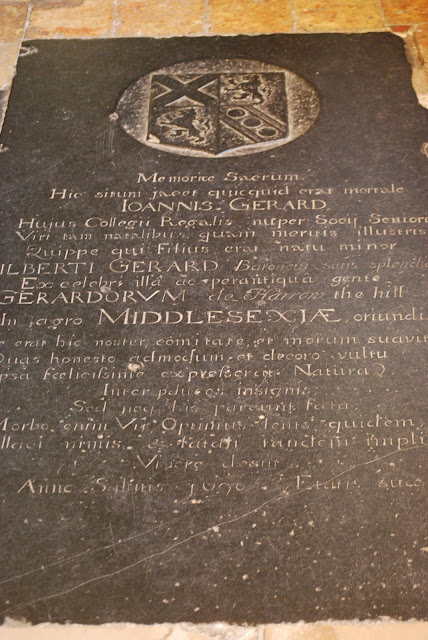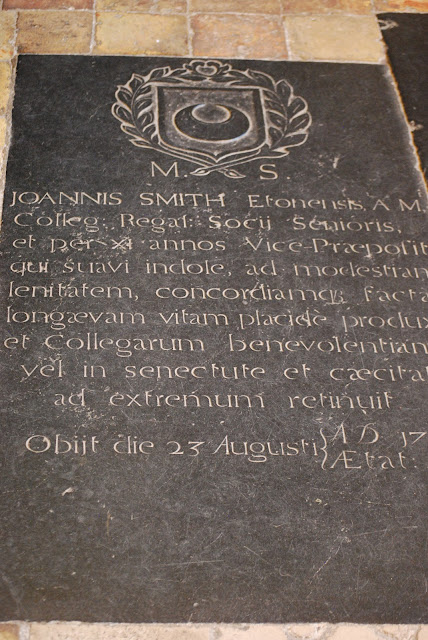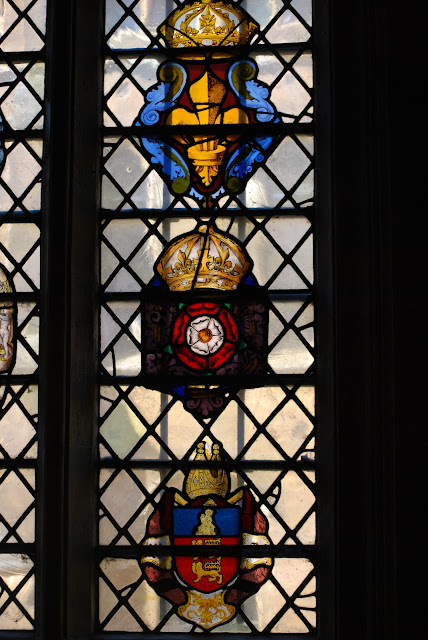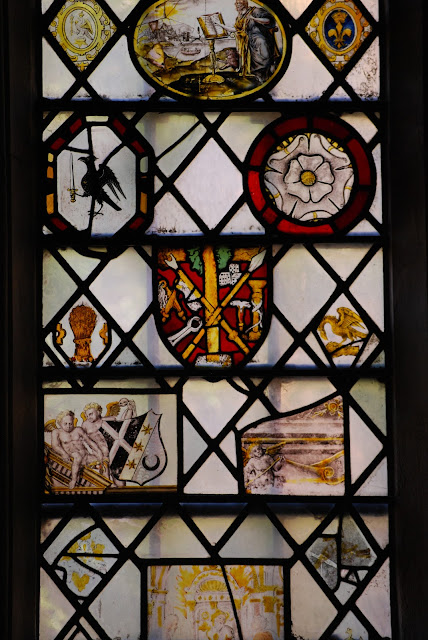This next armorial memorial in King's College Chapel has left me with more questions than answers, I am afraid.
It is the grave of John Gerard, 1637-1690.
Here is the information that I have on him:
John Gerard was born in 1637 in Harrow, London Borough of Harrow, Greater London, England. He was admitted to King's College as a scholar from Eton College in the fall of 1656. He received his B.A. in 1660, and his M.A. in 1664, was Bursar (an official in charge of funds) of King's College, and was a Fellow from 1659-90, when he died and was buried in King's College Chapel.
According to his grave marker, he is the son of Sir Gilbert Gerard, Baronet.
My issue is that I cannot find a Sir Gilbert Gerard, Baronet in any of my Peerage and Baronetage books. William Gerards aplenty, and even a few Thomas Gerards. But no Gilbert Gerard, Bt.
Further, the arms on the marker are more complex than those of the baronets Gerard:
Without tinctures, it's hard to be certain, but my guess at a blazon of these arms would be: Quarterly: 1, Argent a saltire gules (Gerard); 2 and 3, Azure a lion rampant crowned or (the second and third quarters of Baron Gerard of Gerard's Bromley, extinct 1707); 4, (without tinctures, could be any one of several families bearing [Field] on a bend cotised [tincture] three roundels [tincture] (per Papworth)).
Now, there is a Gilbert Gerard (d. 1622), 2nd Baron Gerard of Gerard's Bromley, Staffordshire, but there is no mention of a son John, only his successor, Dutton Gerard, 3rd Baron, and three daughters. And the dates are impossible (a man who died in 1622 having a son in 1637!), so this does not seem to be a match to Gilbert Gerard, Bt.
It's all very annoying; it's not usually so difficult to track down a Baronet, but this time I find myself at a bit of a loss, and leaving me with a number of questions, the biggest one of which is: Was John's father Gilbert really a baronet?
Nonetheless, it's a nice armorial memorial to a scholar and bursar of the College, and I felt the need to share it with you.
AN UPDATE:
After being pointed in the right direction by commenter Philip Allfrey (who also offered an explanation of why I couldn’t find this Gerard baronetcy in any of my books), I did some more searching and found a copy of Burke’s
Extinct and Dormant Baronetcies, 2d ed. (1844) on-line (the .pdf now downloaded to my computer for future reference). Therein we have the following information:
Gilbert Gerard, esq., of Flamberde, in the parish of Harrow-on-the-Hill, Middlesex, eldest son of William and Dorothy (Ratcliff) Gerard, was created Baronet in 1620, and represented Middlesex in Parliament. He married Mary, daughter of Sir Frances Barrington, baronet, and had issue,
Francis, his heir.
Gilbert (Sir).
Thomas.
John [the John of the memorial in King’s College Chapel]
Mary, died unmarried.
Winifred, married Tristram Conyers, esq., sergeant-at-law.
Katherine, married Sir Charles Pym, baronet.
_____, married Sir John Heydon.
The baronetcy descended to Sir Gilbert’s eldest son, Francis, and then to each of Sir Francis’ three sons successively: Sir Charles Gerard, who having only a daughter, was succeeded on his death in 1701 by his brother; Sir Francis Gerard, who dying in August 1704, was succeeded by his brother; Sir Cheek Gerard, at whose decease unmarried in February 1715, the baronetcy became extinct.
And there you have it! What was once a conundrum, with a little help from my readers, is no longer a mystery. Thank you, Philip!






















